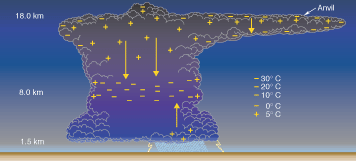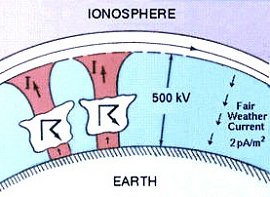|
Scientists are sending unmanned aircraft into
electrical storms to learn more about the mysterious inner workings
of thunderstorms.
by Patrick L Barry
There's much more to
a thunderstorm than meets the eye. Literally. If you could see the
invisible force fields around magnets and clothes that have "static
cling," a storm on the horizon would look very different.
Engulfing and dwarfing
the storm clouds, ghostly ribbons of huge magnetic and electric
fields would arch high above the thunder clouds to the top of the
atmosphere, and would sprawl downward from the clouds like tendrils
groping the landscape. These invisible fields are always in motion,
swelling and contorting as the storm clouds churn, lurching suddenly
as lightning bolts strike.
Scientists have long
assumed that this mostly hidden side of thunderstorms serves as
the electrical "pump" that maintains a huge difference in charge
between the earth's surface and an upper layer of the atmosphere
called the ionosphere. There's a voltage drop between the two, measuring
somewhere between 150,000 and 600,000 volts. Left to itself, this
difference should naturally balance out in about 15 minutes, but
it doesn't.
So a pump must exist.
Unfortunately, the numbers don't add up. Scientists are still trying
to figure it out: All the cloud-to-ground lightning strikes occurring
over the whole planet - about 15 strikes per second - don't move enough
electric current to maintain the charge difference seen. Something
else must be happening.

Image courtesy The Aerospace Corporation
Thunderstorms are also huge electrical dynamos.
|
"There are other sources
besides lightning, and that's part of what we're trying to get a
handle on," says Richard Blakeslee, a scientist at the Global Hydrology
and Climate Centre at NASA's Marshall Space Flight Centre
He explains: "The earth
and its atmosphere are like a giant electric circuit. In fair weather,
the charge difference between the ionosphere and the ground drives
a steady trickle of current from the atmosphere to the ground, despite
the fact that air is a poor conductor of electricity."

Image courtesy NASA
Earth's surface and the ionosphere form an electrical circuit.
Thunderstorms help keep the current flowing.
|
"So something must
drive a current back from the earth up into the atmosphere to complete
the loop and keep the circuit flowing - namely thunderstorms. The
two flows should be equal, but so far we still haven't 'balanced
the budget'."
To take a closer look
at what's happening, Blakeslee and colleagues have used a novel
way of monitoring thunderstorms. They flew a modified version of
the Predator unmanned aerial vehicle (UAV) used in the recent Iraq
War, "conscripting" a version of the aircraft into civilian duty
to fly over thunderstorms near Key West, Florida.
Their high-altitude
version of the UAV, called the Altus II, can measure the invisible
electric and magnetic fields enveloping the storm. As the UAV flies
over the storm clouds, it passes through these fields, sensing the
strength and direction of the fields at points along its flight
path.
Combined with optical
measurements of lightning flashes, the result is a much more complete
picture of the electrical infrastructure of thunderstorms.
"One of the things
we can measure with this experiment is the current flowing above
a thunderstorm," Blakeslee says. "It may be that there's very little
current flowing out of the top of the storm, but if you take all
the thunder clouds over the whole earth that are producing that
small amount of current, it may very much account for this discrepancy
in the atmosphere's electricity budget."
Where does this current
come from? Blakeslee suggests one possibility.

Image courtesy NASA
The
Altus unmanned aerial vehicle.
|
"When the storm's electric
fields get strong enough, the earth's surface under the storm becomes
charged. Grass, trees, people and everything start giving up a charge
that flows up into the atmosphere. Sometimes that's manifested in
something that can be seen like St. Elmo's Fire. Generally you don't
see it, but it's occurring all the time under storms," he says.
The hunt to quantify
this missing current continues. Blakeslee's team is still processing
the data they gathered, and they hope to publish some of their results
within the next few months. One thing their research has already
shown, though, is the usefulness of these unmanned aircraft.
"These unmanned craft
are an important new tool for studying storms," he says. "They allow
us to have much longer and more continuous observations compared
to manned airplanes, so they give us a fuller picture of what's
going on."
The UAV flies much
slower than normal planes (150 mph vs. ~500 mph) and can turn around
much quicker. So while a manned plane would quickly zoom over a
storm and then spend a long time turning around for another pass,
UAV's can simply do slow "figure 8's" over the storm for hours,
gathering data continuously.

Image courtesy NASA
Some of the flight patterns used during the storm
observations
|
Geosynchronous satellites
can also provide a continuous view of storms, but these little remote-controlled
planes offer some advantages.
"The UAV flies in the
midst of the electrical and magnetic fields. Because it's so close
to the storm it can pick up very small optical signals that distant
satellites would miss," Blakeslee says.
"So there is a place
in the future for UAV aircraft that could continuously observe storms,"
he says, which will help scientists get a clearer view of the hidden
electrical life of thunderstorms.
|
